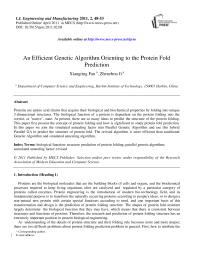An Efficient Genetic Algorithm Orienting to the Protein Fold Prediction
Автор: Xiangting Fan, Zhenzhou Ji
Журнал: International Journal of Engineering and Manufacturing(IJEM) @ijem
Статья в выпуске: 2 vol.1, 2011 года.
Бесплатный доступ
Proteins are amino acid chains that acquire their biological and biochemical properties by folding into unique 3-dimensional structures. The biological function of a protein is dependent on the protein folding into the correct, or "native", state. At present, there are so many ideas to predict the structure of the protein folding. This paper first present the concept of protein folding and how is significant to study protein fold prediction. In this paper we join the simulated annealing factor into Parallel Genetic Algorithm and use this hybrid Parallel GA to predict the structure of protein fold. The revised algorithm is more efficient than traditional Genetic Algorithm and simulated annealing algorithm.
Biological function, structure prediction of protein folding, parallel genetic algorithm, sumulated annealing factor, revised
Короткий адрес: https://sciup.org/15014121
IDR: 15014121
Список литературы An Efficient Genetic Algorithm Orienting to the Protein Fold Prediction
- H.S. Chan ,K.A. Dill, Energy landscapes and the collapse dynamics of homopolymers, J. Chen. Phys, 1993, 99(3) , pp. 2116-2427.
- J. H. Holland, Adaptation in Nature and Artificial Systems. The University of Michigan Press, 1975.
- Lishan Tang, Non-numerical computation-Simulated Annealing Algorithm, 1rd ed. Being Jing: The Science Publishing Company, 1998. (in Chinese)
- H. P. Hsu, V. Mehra. W.Nadler, P,Grassberger, “Growth algorithms for lattice heteropolymers at low temperatures,” Chem. Phy,2003(1).
- J. B. Martin, J. Gareth and W. Peter, “GENFOLD: A parallel genetic algorithm for protein folding prediction using the 3D-HP Side Chain model,” Evolutionary Computation,2009,CEC’09, pp,1297–1304.
- H. Li,R. Helling, C. Tang, “Emergence of preferred structures in a simple model protein folding,” Science, 1996, 273, pp. 666–669.
- W. J. Jiang, D.T. Luo, Y.S. Xu, X.M.Sun, Hybrid genetic algorithm research and its application in problem optimization, Intelligent Control and Automation,2004, pp. 2122–2126, Vol.3.
- Shamenm. Akhter, Jason. Roberts, Multi-Core Programming: Increasing performance through software multi-threading, publishing house of electronics industry, 2007.
- Dehzang, A. Khosravi and B. G. Fac. Introducing novel physicochenmical based features to enhance protein fold prediction accuracy, ICCDA, 2010, pp. V1-592–V2-596.
- V. Sharma, V. R. I. Kaila, and A. Annila, “Protein folding as an evolutionary process”, Physica A, 2009, 388(6), pp. 851–862.


